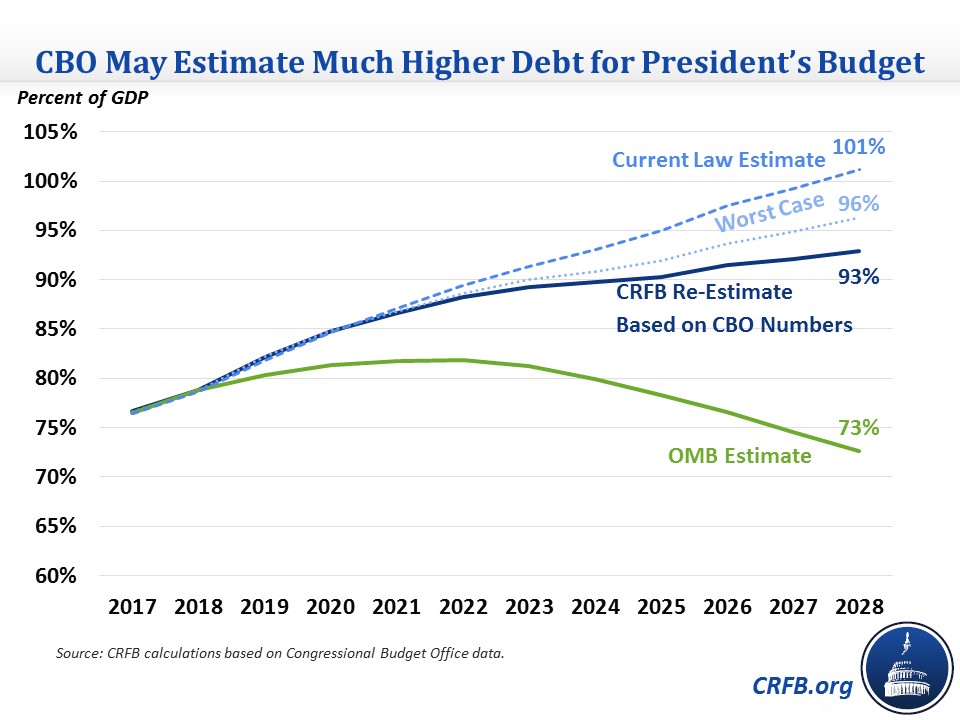Debt Could Be 20 Percent of GDP Higher than President's Budget Claims
The Congressional Budget Office (CBO) typically publishes its own estimate of the President's budget about a month after the budget's initial release, but we predict that CBO will show much higher deficits and debt as a percent of Gross Domestic Product (GDP) than the Office of Management and Budget (OMB) estimates. When we incorporate the effect of CBO's more realistic assumptions, the enactment of the budget deal (which the budget didn't account for), and other ways in which CBO might estimate the budget differently, we find that debt in 2028 under the budget would be 93 percent of GDP or 20 percentage points higher than OMB predicts, with a worst-case scenario of 96 percent.
By far the biggest difference between OMB's estimate of the President's budget and our estimate based on CBO data is the economic assumptions. OMB's extremely optimistic projections have economic growth averaging 3 percent over the next decade while CBO's projections from last June have growth averaging around 1.8 percent, which the dynamic effect of the tax bill would boost only minimally. More realistic economic projections both reduce projected GDP in 2028 by 11 percent, which raises debt as a percent of GDP by 8 percentage points, and reduce revenue enough to raise debt another 10 percentage points.
On top of that, we adjust other numbers in the budget based on the recently-passed budget deal and remove some savings that CBO is unlikely to score. Adjusting for the budget deal removes some short-term non-defense cuts (the Administration would adhere to 2018 spending levels and have higher 2019 levels than their budget does) and removes smaller spending increases and cuts that the budget deal already included. We also remove unrealistic savings for reducing improper payments and testing strategies to get Disability Insurance beneficiaries to return to work, neither of which CBO found specific enough to score for last year's budget, and score a few other policies differently based on how OMB and CBO scored them last year.
When all of these adjustments are accounted for, debt in the President's budget increases to 93 percent of GDP in 2028. This 20-point gap between the OMB estimate and our "CBO" estimate is similar to the one for last year's budget.

We estimate the budget would continue to show a sizeable increase in deficits in the near term, peaking at more than $1.2 trillion in 2019. Afterwards, it would fall a bit and stabilize at around 4 percent of GDP, a relatively high amount for a full employment economy.
The budget could look worse if its roughly $900 billion of unspecified cuts to non-defense discretionary spending don't materialize. CBO is likely to score these as savings, but they are very deep cuts and represent a big reversal from the large spending increases recently enacted for the next two years. If these unspecified cuts did not happen, which we call the worst-case scenario, the President's budget would result in debt rising to 96 percent of GDP by 2028. Either of these numbers would be an improvement on our estimate of current law, which has debt reaching 101 percent of GDP by 2028, but they would still leave debt on a sharp upward path.
Of course, these numbers are not official CBO estimates, and CBO's numbers could be quite different (in either direction) than this estimate since it has not updated its budget and economic projections since June. Still, it seems likely that like last year, CBO will find much higher debt than OMB estimated. With the more challenging fiscal situation we now face after the passage of large deficit-increasing legislation, that is not good news.


